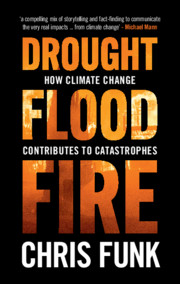Book contents
- Drought, Flood, Fire
- Drought, Flood, Fire
- Copyright page
- Contents
- Acknowledgments
- 1 Climate Extremes, Climate Attribution, Extreme Event Attribution
- 2 Welcome to an Awesome Planet
- 3 The Earth Is a Negentropic System, or “the Bright Side of Empty”
- 4 Do-It-Yourself Climate Change Science
- 5 Temperature Extremes – Impacts and Attribution
- 6 Precipitation Extremes
- 7 Hurricanes, Cyclones, and Typhoons
- 8 Conceptual Models of Climate Change and Prediction, and How They Relate to Floods and Fires
- 9 Climate Change Made the 2015–2016 El Niño More Extreme
- 10 Bigger La Niñas and the East African Climate Paradox
- 11 Fire and Drought in the Western United States
- 12 Fire and Australia’s Black Summer
- 13 Driving toward +4°C on a Dixie® Cup Planet
- 14 We Can Afford to Wear a White Hat
- Appendix A Few Resources for Further Reading and Research
- Index
8 - Conceptual Models of Climate Change and Prediction, and How They Relate to Floods and Fires
Published online by Cambridge University Press: 01 June 2021
- Drought, Flood, Fire
- Drought, Flood, Fire
- Copyright page
- Contents
- Acknowledgments
- 1 Climate Extremes, Climate Attribution, Extreme Event Attribution
- 2 Welcome to an Awesome Planet
- 3 The Earth Is a Negentropic System, or “the Bright Side of Empty”
- 4 Do-It-Yourself Climate Change Science
- 5 Temperature Extremes – Impacts and Attribution
- 6 Precipitation Extremes
- 7 Hurricanes, Cyclones, and Typhoons
- 8 Conceptual Models of Climate Change and Prediction, and How They Relate to Floods and Fires
- 9 Climate Change Made the 2015–2016 El Niño More Extreme
- 10 Bigger La Niñas and the East African Climate Paradox
- 11 Fire and Drought in the Western United States
- 12 Fire and Australia’s Black Summer
- 13 Driving toward +4°C on a Dixie® Cup Planet
- 14 We Can Afford to Wear a White Hat
- Appendix A Few Resources for Further Reading and Research
- Index
Summary
The amount of energy in the upper ocean is increasing very rapidly. Between 2014 and 2019, the global heat energy increase was equivalent to the energy released by about 12 million one-megaton nuclear bombs. But global warming does not produce an even warming of the world’s oceans. Rather, extra energy builds up and moves around in complex ways. Understanding this fact can save lives. In the near term, this recognition can lead to successful forecasts. In the longer term, this recognition will help us reduce our emissions because we can recognize now how climate change is contributing to extreme weather and catastrophes. For example, in October and November 2019, the western Indian Ocean reached the highest levels of warmth ever observed, while the eastern Indian Ocean was anomalously cold. This combination contributed to extreme flooding and locust outbreaks in East Africa and exceptionally warm and dry conditions over southern Africa and Australia. An accurate conceptual model of climate change can create opportunities for prediction. Adopting an incorrect conception of climate change as the average of collections of climate simulations can cause us to miss these opportunities.
Keywords
- Type
- Chapter
- Information
- Drought, Flood, FireHow Climate Change Contributes to Catastrophes, pp. 164 - 185Publisher: Cambridge University PressPrint publication year: 2021

